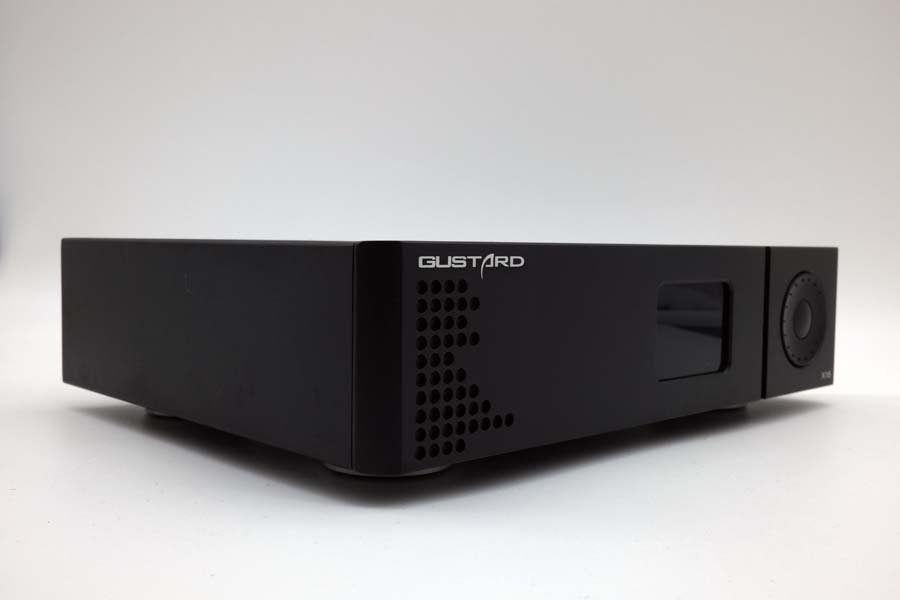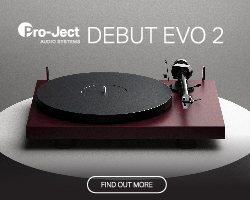GUSTARD DAC X-16 MQA REVIEW
The Gustard DAC-X16 MQA is an MQA capable digital to analogue convertor hailing from China and costing £459 $500. Stuart Smith takes a listen.

A nice and simple front panel makes the X-16 look very classy.
BUILD AND FEATURES
Externally this is a very nicely put together unit and looks good. It’s small enough to be used desktop and certainly feels like a quality bit of kit. It weighs 2.5Kg and measures 22cm x 50cm x170cm and comes in either black (as per the sample unit) or silver. On the front there is the brand name and the model number and then a small OLED display which is fine for desktop but too small to be seen across the room. Finally, there is a dial and button combo to the right of the unit for control and set up, though a small but perfectly functional remote is included in the package. A power cable and USB cable are also in the package, as is a Bluetooth antenna and a driver disc. The four feet underneath the box are non-slip and look nicely machined, though they are not adjustable.
So far there’s little not to like about the Gustard.
Round the back you have XLR and RCA outputs, and then digital inputs that include optical, coaxial, AES, USB and IIS. There is the Bluetooth antenna input and then the main IEC and master power switch.
Inside the DAC chips are the ES9068AS from ESS, with two being used in this model. For USB there’s an XMOS xCORE-200 16 core XU216 processor that allows for 32 Bit PCM, and DSD and it will allow input from Win7 to 10 (32 or 64Bit) as well as Linux. Coax, AES, and optical inputs allow for PCM 16-24 Bit/44.1-192kHz and DSD DOP 64. There is also the IIS input that will offer the same specs as USB. Bluetooth is Bluetooth 5.0.

Balanced outs and a whole load of digital inputs.
This is pretty impressive stuff for such a small and well-priced box.
SET UP

Inputs include prtovision for the included Bluetooth antenna.
Nothing to it. Plug the USB out of the Raspberry Pi running Roipee into the DAC, plug the RCA or XLRs into the back of the old Krell, plug it into the mains, find the Gustard on Roon and rename. Hey presto, music. This makes for a very simple set up and feasibly you could run a full streaming rig with just this, a Raspberry pi or other streamer, an amp and speakers, or even straight into a pair of powered speakers. This may not seem a big deal to most readers but there is plenty of folk out there looking for systems that just play music and don’t get in the way. It’s not as compact a system as using the DAC 32 I reviewed recently, but it’s still relatively bijou.
SOUND
Truth be known, I wasn’t expecting a great deal from the Gustard, but overall I’ve been pretty impressed with what it can do. My first overall impression from it was that it wasn’t as “organic” sounding as the LAB12 DAC that it replaced in this system, and secondly it isn’t as critically resolving as the Leema DAC we use in the main system. However, this is a sub-£500 DAC and the DACs mentioned are far more costly.
It is certainly very quiet – there is no discernible noise between tracks whatsoever. Soundstaging I’d say isn’t as expansive as the two other DACs I’ve mentioned and music feels a little more “closed in” in comparison, though imaging within the stage is very good if a little flat. With all that said, the Gustard is certainly pretty impressive to listen to, though it has limitations that will become evident. As I’m sat typing up my notes, Moby’s version of Heroes comes on and immediately catches my attention – it’s fairly impressive that a €500 DAC is able to make this kind of sound and shows how far DAC design has come.
Neil Landstrumm’s Busy Making Videos has plenty going on in the mix and the X16 copes very well with everything that is thrown at it. However, I just feel that the music isn’t as exciting as it should be – something is missing that gives my other DACs the edge in this regard. Don’t get me wrong, this is not terrible in any way and I could be well happy listening to the Gustard forever, but it’s not got that little bit of sparkle that sets great kit apart from the herd. I got this feeling throughout my time with the Gustard – not missing anything but not really falling in love with it either.
Hardfloor’s Trancesript has the 303 sounding like a 303 but without quite the bite I’m used to and with the Gustard failing to capture the raspiness of the little silver acid box. It’s there, but it feels a little bit sterile and flat when compared to the other DACs we have to hand. I can still enjoy the music, and were I not such a critical person, or perhaps had I not being spoiled by having such great kit at my disposal, the Gustard would have served my needs very well – and in many ways, I think this is how to look at the X16. It’s a good sounding DAC that produces music without leaving much out, but doesn’t really excite and give that connection to the music you are listening to – perhaps the DACs further up the Gustard chain are able to offer more in this regard.
Listening to Daft Punk’s Contact it’s clear that the X16 is a very clean sounding DAC and there’s no distortion to the sound in the upper frequencies (other than the distortion that is there on this track). The drums that are panned all over the place on the tune are represented very well in the mix, but in the final analysis, seem to lack a bit of the punch that I’m used to, and again I’m left feeling a little like I’m missing something but I don’t know what. The “noise” towards the end of this track is very complex in its makeup and the Gustard demonstrated that well with me being able to hear the layers of sound. One More Time is punchier in its mix but still feels a little flat here.
The X16 manages to pull out the massively deep kick and bassline on Stacey Pullen’s Rok track and again everything is portrayed very well and with little to complain about, but again with little to get you climbing the drainpipe, getting your top off, and screaming from the rooftops as to how brilliant this DAC is.
Listening to the chilled jazz of Paolo Fresu and Lars Danielsonn’s Summerwind record it’s very easy to fall into the music and be seduced by the chilled nature of the presentation. And I think this gets to the crux of what the character of this DAC is all about – on tunes where I’m looking for energy, vitality and pace I was left wanting, on more chilled music I found myself drifting into the tunes and getting right into it. The question then would be “Is the X16 a bit boring?” and I suppose it sort of is if I’m honest. That’s a bit unfair, actually, and as opposed to boring I think a better way to describe its character is chilled and undemanding.
Mid-band is lush and full and is where the Gustard scored really highly. Vocals were easy to decipher and there is a good insight into tone and detail in the performer’s voice. In lots of ways, I could see some describing this as an “audiophile” sounding DAC.
I’m not an MQA aficionado and being MQA compliant is not something I would seek out in a product, so I’m not going to go further than to say that with all the tracks I tried with MQA encoding the Gustard worked fine.

The small screen is difficult to see from normal listening position but adequate for simple set-up.
Bluetooth is easy to set up. Go into the menu, turn on the Bluetooth power and the computer or phone sees the DAC immediately. Select BT input with the remote and you are away. We often have issues with Bluetooth in the house but the Gustard performed flawlessly. Bluetooth streaming is what it is to my mind and I rarely use it – it worked fine!
CONCLUSION
In some ways I’d describe the Gustard as pretty “workaday” – it doesn’t do anything wrong, but it doesn’t connect me with the music like my other DACs. For me, it is missing that certain something that’s really hard to quantify.
However, on chilled jazz and the likes of the Café del Mar series of records, it’s a really good match with that Sunday morning come-down feel to it. I have to say that if I didn’t listen to so much fast-paced techno etc then this would have got a better score than it will get.
I’d have liked to have seen a headphone output on it which would have made it a very good desktop DAC for not a lot of money
Overall, I reckon this offers great value for money and should be considered as being a highly capable DAC…with the caveats outlined.
This is a good sounding and well-built DAC that takes up minimal real estate and sounds very good when it’s partnered with the right music. I certainly don’t think it will be all things to all people but for those who like this kind of presentation, it will be a big hit!
AT A GLANCE
Build Quality:
Compact and very well put together. Nothing to fault here at all
Sound Quality:
For my taste, it lacks excitement and drive. With chilled out tunes it’s actually a very nice and undemanding DAC to listen to
Value For Money:
The X-16 represents great value for money in my opinion if you are happy with its laid back approach and presentation
We Loved:
Good choice of digital inputs
Bluetooth connectivity
Great build
Simple to get working – pretty much plug and play
Lush mid-band presentation
Good value for money
RCA and XLR outputs
Great package and packaging
We Didn’t Love So Much:
Just a little on the lush side to really fire the excitement buttons
No headphone
Price: $500
Elevator Pitch Review: Well built and good sounding DAC that errs on the side of being inoffensive and laidback – if a little too much for my tastes. The feature set is great for the money and it only lacks a headphone amplifier.
Stuart Smith

Review Equipment: Krell KTA100, Rspberry Pi running Roipee, Roon, Falcon LS3/5a Gold label and Diptyque dp77 loudspeakers. Atlas and Tellurium Q cables.












































































































































































































